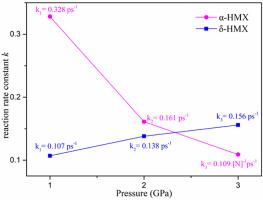Energetic Materials Frontiers ( IF 3.3 ) Pub Date : 2020-08-31 , DOI: 10.1016/j.enmf.2020.08.003 Xiaowei Wu , Zhichao Liu , Weihua Zhu

|
The coupling effect of temperature and pressure plays a significant role in the behavior of energetic materials. Energetic materials present extremely complex behavior at high temperatures. Handling difficulties and safety risks have restricted detailed experimental studies on their decomposition mechanisms, especially for less-stable configurations of energetic materials. This has necessitated theoretical studies particularly under the coupling effect. A combinational strategy based on density functional tight-binding molecular dynamics (DFTB-MD) simulations and the density functional theory (DFT) was applied to study the effects of temperature and pressure on the initial decomposition and reaction activation barrier of α-octahydro-1,3,5,7-tetranitro-1,3,5,7-tetrazocine (HMX) and δ-HMX. A comprehensive analysis of HMX in each system indicated that while the initial decomposition mechanism was not dependent on pressure at high temperatures, the initial reaction rate and activation barrier were highly dependent on pressure. The initial decomposition mechanisms of α-HMX at 1500 K and δ-HMX at 1200 K under pressures of 1–3 GPa involved unimolecular C–H bond breakage and N–NO2 homolysis, respectively. Pressure inhibited the decomposition of α-HMX, but accelerated that of δ-HMX. The decompositions of α-HMX and δ-HMX occurred via first-order reactions. The classical Arrhenius form indicated that pressure (1–3 GPa) increased and decreased the decomposition barriers of α-HMX at 1500 K and δ-HMX at 1200 K, respectively. These findings provide a new understanding of the thermal decomposition and reaction mechanisms of HMX under the coupling effect of temperature and varying pressures.
中文翻译:

高温高压耦合对结晶HMX分解机理的影响
温度和压力的耦合效应在高能材料的行为中起着重要作用。高能材料在高温下表现出极其复杂的行为。处理困难和安全风险限制了对其分解机理的详细实验研究,特别是对于能量材料配置较不稳定的情况。特别是在耦合作用下,这就需要进行理论研究。应用基于密度泛函紧密结合分子动力学(DFTB-MD)模拟和密度泛函理论(DFT)的组合策略,研究温度和压力对α -octahydro-1的初始分解和反应活化势垒的影响,3,5,7-四硝基-1,3,5,7-四唑啉(HMX)和δ-HMX。对每个系统中HMX的综合分析表明,尽管初始分解机理不依赖于高温下的压力,但初始反应速率和活化势垒高度依赖于压力。在1–3 GPa的压力下,1500 K时α- HMX和1200 K时δ- HMX的初始分解机理分别涉及单分子C–H键断裂和N–NO 2均质化。压力抑制了α- HMX的分解,但加速了δ- HMX的分解。α- HMX和δ的分解-HMX通过一阶反应发生。经典的Arrhenius形式表明,压力(1-3 GPa)分别增加和减少了1500 K时α- HMX和1200 K时δ- HMX的分解势垒。这些发现为HMX在温度和压力变化的耦合作用下的热分解和反应机理提供了新的认识。











































 京公网安备 11010802027423号
京公网安备 11010802027423号